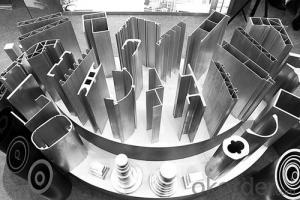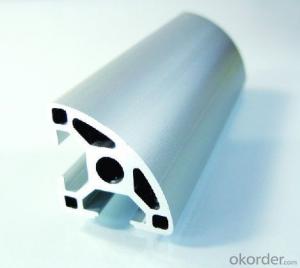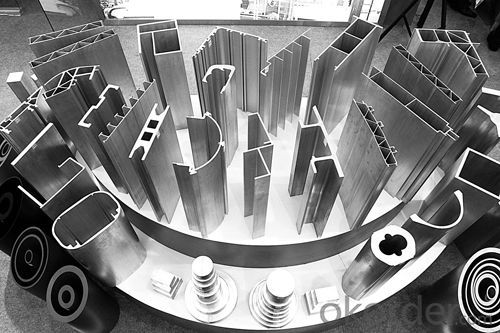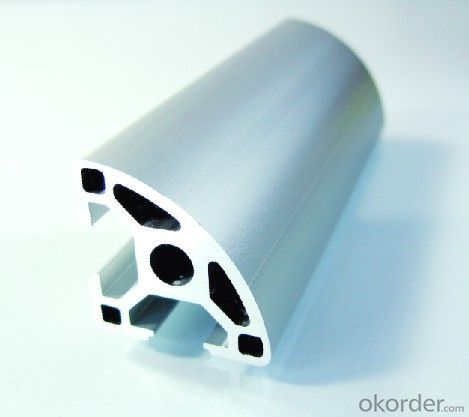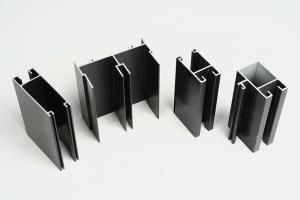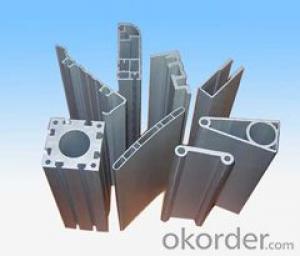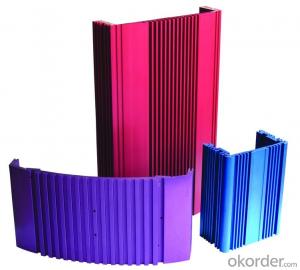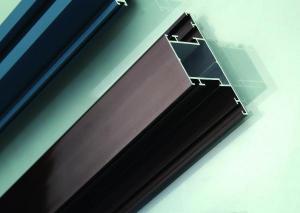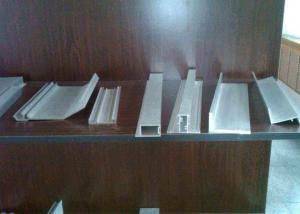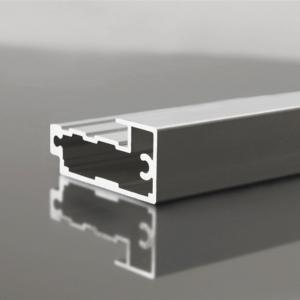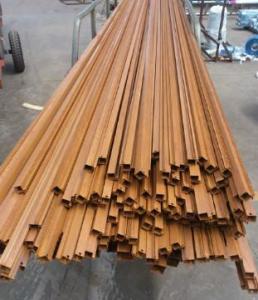Aluminum Extrusion Profiles 2.5 X 2.5 for Aluminum Window and Door Profile
- Loading Port:
- China Main Port
- Payment Terms:
- TT OR LC
- Min Order Qty:
- -
- Supply Capability:
- -
OKorder Service Pledge
OKorder Financial Service
You Might Also Like
Aluminium is a relatively soft,durable, lightweight, ductile and malleablemetal with appearance ranging from silvery to dull gray,depending on the surface roughness. It is nonmagnetic and does not easilyignite. A fresh film of aluminium serves as a good reflector (approximately92%) of visible light and an excellent reflector (as much as98%) of medium and far infrared radiation. The yield strength of pure aluminium is 7–11 MPa,while aluminium alloys have yield strengths ranging from200 MPa to 600 MPa. Aluminium has about one-third the density and stiffnessof steel. It iseasily machined,cast, drawn and extruded.
Aluminum Profile
Material | Alloy 6063,6061,6005or according to customer’s choice |
Temper | T3, T4, T5, T6 |
Surface | Anodize, electrophoresis, powder coating, PVDF coating, wood grain painting, matted, etc. |
Length | Coating 6.5 meters, Anodizing 6.5 meters, Mill finish 5 meters |
Application | Industrial, electrical equipment(TV set, air conditioner, refrigerator, computer), decoration,construction, transportation |
Custom Made | We can package following with customer's request. |


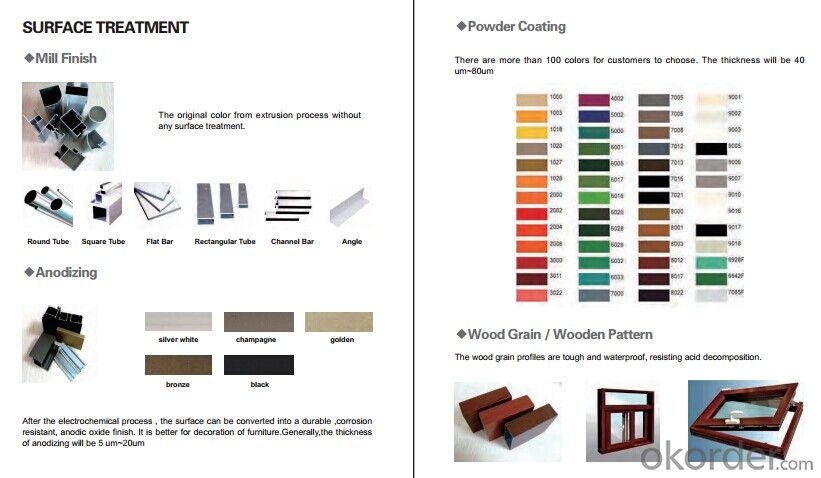
- Q: What are the advantages of using aluminum profiles in the telecommunications infrastructure?
- Using aluminum profiles in the telecommunications infrastructure offers several advantages: 1. Lightweight: Aluminum profiles are much lighter than traditional materials like steel, making them easier to transport and install. This reduces labor costs and deployment time. 2. Resistant to corrosion: Aluminum has excellent resistance to corrosion, making it ideal for outdoor infrastructure exposed to harsh environmental conditions. It can withstand high humidity and exposure to chemicals. 3. High strength-to-weight ratio: Despite being lightweight, aluminum profiles have a high strength-to-weight ratio. This means they can support heavy equipment and structures while still being relatively light. They are perfect for applications such as antenna mounts and support structures. 4. Easy customization: Aluminum profiles can be easily customized to meet specific design requirements. They can be cut, drilled, or shaped to fit unique specifications, allowing for flexibility in design and installation. 5. Cost-effective: Aluminum profiles are generally more cost-effective compared to materials like steel or fiberglass. They require minimal maintenance, have a long lifespan, and can be recycled, reducing overall costs over the infrastructure's life cycle. 6. Electrical conductivity: Aluminum is an excellent conductor of electricity, making it suitable for telecommunications infrastructure where electrical conductivity is important. 7. Aesthetically pleasing: Aluminum profiles have a sleek and modern appearance, enhancing the overall aesthetics of the telecommunications infrastructure. This is particularly important in urban or residential areas where visual appeal is considered. Overall, the use of aluminum profiles in telecommunications infrastructure offers benefits such as lightweight design, corrosion resistance, high strength-to-weight ratio, customization options, cost-effectiveness, electrical conductivity, and aesthetic appeal. These advantages make aluminum profiles the preferred choice for various components within the telecommunications industry.
- Q: Can aluminum profiles be used in lightweight construction applications?
- Aluminum profiles are definitely applicable in lightweight construction. They possess a lightweight and versatile nature that brings numerous advantages to construction projects. With a high strength-to-weight ratio, structures can be built with less material yet still maintain strength and durability. This makes aluminum profiles an ideal choice for lightweight construction where weight reduction is crucial. Various construction projects, including building facades, interior partitions, roofing systems, and structural frameworks, commonly utilize aluminum profiles. They are particularly favored in industries such as aerospace, automotive, and marine where reducing weight is of utmost importance. Additionally, aluminum profiles exhibit excellent resistance to corrosion, making them suitable for outdoor and high-moisture environments. Their high malleability allows for easy fabrication into different shapes and sizes, enabling customized designs and simple installation. Moreover, aluminum is an eco-friendly material as it can be recycled infinitely without compromising its properties. To sum up, the widespread use of aluminum profiles in lightweight construction stems from their lightweight nature, strength, durability, corrosion resistance, malleability, and environmental benefits.
- Q: What is the maximum length of aluminum profiles available?
- The maximum length of aluminum profiles available can vary depending on the supplier and specific requirements, but it is typically around 6 meters (20 feet).
- Q: What are the advantages of using aluminum profiles in the defense industry?
- There are several advantages of using aluminum profiles in the defense industry. Firstly, aluminum profiles offer a high strength-to-weight ratio. This means that they can provide the necessary strength and durability while being lightweight. This is particularly crucial in the defense industry where weight reduction is essential for enhancing mobility and reducing fuel consumption. Secondly, aluminum profiles have excellent corrosion resistance properties. This is particularly advantageous in defense applications where equipment is exposed to harsh environments, such as saltwater or extreme weather conditions. The corrosion resistance of aluminum profiles ensures that the equipment remains functional and reliable for extended periods, reducing maintenance requirements and increasing the overall lifespan of the components. Furthermore, aluminum profiles are highly malleable and can be easily fabricated into complex shapes and designs. This versatility allows for greater design flexibility in defense applications, enabling the creation of intricate and tailored components. Additionally, aluminum profiles can be easily joined with other materials, such as composites or steel, further expanding their potential applications in the defense industry. Another advantage of aluminum profiles is their excellent thermal conductivity. Aluminum has a high thermal conductivity compared to other metals, allowing for efficient heat dissipation in defense equipment. This is particularly important in applications where thermal management is critical, such as electronic systems or high-performance vehicles. The ability of aluminum profiles to dissipate heat effectively ensures the reliability and longevity of sensitive components. Lastly, aluminum is a widely available and cost-effective material. It is abundant in nature and can be easily extracted, making it readily accessible for defense manufacturing. Moreover, its low cost compared to other metals such as titanium or steel makes it an economical choice for defense applications, allowing for cost-effective production of large quantities of components without compromising on quality or performance. In conclusion, the advantages of using aluminum profiles in the defense industry include their high strength-to-weight ratio, corrosion resistance, versatility in fabrication, excellent thermal conductivity, and cost-effectiveness. These characteristics make aluminum profiles an ideal choice for a wide range of defense applications, contributing to enhanced performance, durability, and cost-efficiency in this critical sector.
- Q: Is it possible to utilize aluminum profiles as part of the exterior cladding systems for commercial buildings?
- <p>Yes, aluminum profiles are commonly used for exterior cladding systems in commercial buildings. They offer several advantages such as durability, resistance to weather and corrosion, low maintenance, and a modern aesthetic. Aluminum's lightweight nature and strength make it an ideal material for cladding, and it can be easily shaped and joined to create a variety of designs. Additionally, aluminum profiles can be coated or anodized to provide color and further protection against the elements.</p>
- Q: What are the reasons for the large number of products in the aluminum profile cutting machine after opening?
- When sawing, lubrication is insufficient, check the lubrication system, and the other may be aluminum material is not good
- Q: Are aluminum profiles suitable for electrical conductivity applications?
- Electrical conductivity applications are not suitable for aluminum profiles. Despite aluminum being a proficient conductor of electricity, the presence of an oxide layer on the surface of aluminum profiles typically obstructs electrical conductivity. Furthermore, aluminum profiles are susceptible to corrosion, ultimately affecting their conductivity. Consequently, materials with superior conductivity attributes like copper or silver are generally favored for electrical conductivity applications.
- Q: Can aluminum profiles be used for exhibition booths?
- Yes, aluminum profiles can be used for exhibition booths. Aluminum profiles are lightweight, durable, and easy to assemble, making them a popular choice for constructing exhibition booths. They can be easily customized to fit specific design requirements and can be used to create walls, frames, and structures for displaying products and promotional materials. Additionally, aluminum profiles can be easily transported and stored, making them a practical choice for exhibition booths that need to be set up and dismantled multiple times. Overall, aluminum profiles offer versatility and convenience in creating visually appealing and functional exhibition booths.
- Q: This question asks about the various methods used to finish aluminum profiles, including painting and coating.
- <p>Aluminum profiles can be finished in several ways to enhance their appearance, durability, and functionality. Common methods include: 1. Anodizing, which provides a protective oxide layer and can be colored. 2. Powder coating, an electrostatic process that offers a durable and colorful finish. 3. Painting, which can be done with various types of paint for aesthetic or protective purposes. 4. Polishing, which gives a shiny, smooth surface finish. 5. Brushing, creating a textured, satin-like appearance. 6. Electroplating, which deposits a thin layer of metal onto the aluminum for decorative or protective reasons. Each method has its advantages and is chosen based on the specific requirements of the application.</p>
- Q: How about the price of aluminum profile?
- Aluminum prices are calculated according to the price of aluminum ingot + processing fees, such as: aluminum ingot price 16000+, processing fee 6000 = 22000 yuan / ton
Send your message to us
Aluminum Extrusion Profiles 2.5 X 2.5 for Aluminum Window and Door Profile
- Loading Port:
- China Main Port
- Payment Terms:
- TT OR LC
- Min Order Qty:
- -
- Supply Capability:
- -
OKorder Service Pledge
OKorder Financial Service
Similar products
Hot products
Hot Searches
Related keywords
